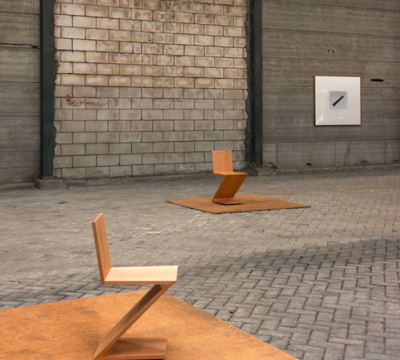simon van til
Simon van Til (Doesburg, 1985) analyses the properties of the camera and utilises their individual qualities. His methodical work is about representation, and about the way in which photography and reality intertwine. He portrays the manner in which the world mirrors itself by means of the camera. Through his work, photography discovers more possibilities than it was ever invented for. He lengthens, for instance, the exposure time, in order to record the distance light travels between the sun and the earth, or he captures the light between sunrise and sunset.
Simon van Til studied at ArtEZ Hogeschool voor de Kunsten Arnhem and De Ateliers, Amsterdam. Previous exhibitions took place at, among other places, the Huis Marseille Museum for Photography, the Tartu Art Museum (Estonia) and the Museum for Modern Art Arnhem.
Thoughtful observation
Young artist Simon van Til (1985) looks at spears. He doesn’t look at the blood, not the fighting soldiers, the ripped-off helmets or the dying horses on the battle field. The tragedy on the triptych painted by Florentine painter Paolo Uccello between 1435 and 1455, depicting the eight-hour Battle of San Romano, passes by van Til entirely.
He looks at the spears, how they, upright and handheld, lying down, aslant, in fore and background, provide the illustrated battle with depth. Also, he looks at the perspective Uccello assimilates over the twenty years he spends working on The Battle of San Romano. From shiftless and disorganised, this perspective evolves into a strongly linear one, with a vanishing point at the centre of the image.
Simon van Til is not a painter, but a photographer, and he increasingly — as he puts it — ‘does something with objects’. His photographs are not about the story of the world. Nor are the objects he chooses for his installations. They tell no story beyond that of being an object, or rather: a representation of an object. Van Til’s work is based on three notions: that of perspective, which exists by mere grace of looking; the position of the work within a space, and distance. Each chosen object — whether it is a framed photograph, an object in the photo or two actual objects in the space — stands in reasoned relation to the other.
This leads to Van Til’s presentations being, despite his young career, discernible from afar. His exhibition at De Ateliers — the top institute for visual artists in Amsterdam, from which he graduated in 2015 — equally emitted the selfsame balance between aesthetics and that which is best described as ‘thoughtful observation’. Van Til doesn’t entice the viewer with pathos. He tempts you to come closer, to take a step back, to contemplate what you see.
At the Noletloodsen, van Till shows two works of, once again, a strong conceptual nature. For the first work, Frame and Vessel, a lead grey freestanding partition was constructed. It’s a gigantic brick wall from the front, from which a tiny 10 by 12,5 centimetre contact print of a photograph is suspended. The print ‘swims’ in a surprisingly large white passepartout. The contact print is exactly the same size as the original negative and its image is enveloped in the same black frame.
The picture on the print displays a ritual Chimú vessel from Peru. In the Pre-Columbian Chimú culture, the vessel served as a gift to the dead, intended for use in the afterlife. It is an elegant little grey vessel. Van Til photographed it several times in 2015. ‘The vessel became a motive,’ he says, ‘rather than a subject.’ The vessel was part of a group of six related objects forming the basis of his work at De Ateliers. All of these objects were centred around the question of the relationship between appearance and the photographic reality of representation. Hence the title Frame and Vessel.
When facing Frame and Vessel, one only sees this photo. Quite different is Van Til’s second work, which actually occupies floorspace. A Form in the Shape of a Thing comprises two reproduced Zig-Zag chairs from cherry wood, designed in 1932 by Gerrit Rietveld, as well as a gelatin silver print of a triangular wedge shape, photographed to actual size. The wedge — nice detail — is a component of the Zig-Zag chair, which fortifies and secures the chair during ‘bending moments’. The wedge is generally a recurring shape in the work of Van Til. The ‘in between thing’ that makes something else possible, is given an extraordinary independence by Van Til.
A Form in the Shape of a Thing – the warning is in the title — is literally no more than three grouped forms, assuming the shape of an object. What does that say about the object? About the image and its value? And what — finally — do these questions remind us of? Precisely: Plato’s metaphor of the cave, where the shadows on the wall led the people in the cave to believe that what they saw was real. When they were in fact no more than simple flat projections.


